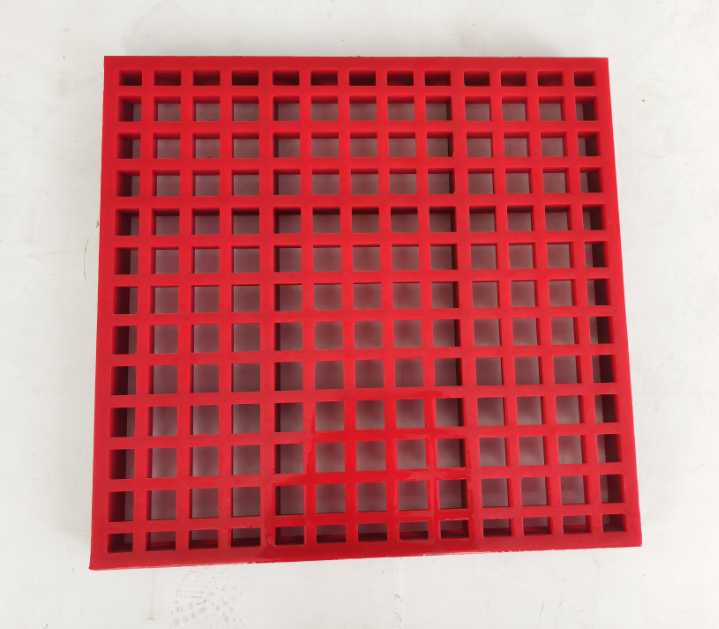고정밀 작업을 위한 PU 스크린 메시의 주요 특징
혹독한 환경에서의 뛰어난 내마모성
PU 스크린 메시는 우수한 마모 저항성을 가지고 있으며, 성능은 고무와 유사합니다. PU 메시 플레이트는 광업, 금속, 석탄, 건축 자재, 수리, 건설 산업 등에서 사용됩니다. 연구에 따르면 이러한 엄격한 조건 하에서 PU 메시의 수명은 전통적인 재료보다 최대 5배 더 길다는 것이 밝혀졌습니다. 메시는 매우 강하고 높은 마모 저항성을 가지며, 이는 특허받은 폴리우레탄 소재의 조합으로 만들어지기 때문입니다. 이를 통해 메시는 항상 완벽한 정밀도로 고품질 디지털 인쇄를 처리할 수 있습니다. 이러한 내구성은 기업들에게 더 적은 다운타임과 교체 비용을 의미합니다.
부식이 발생하기 쉬운 응용 프로그램을 위한 화학적 안정성
폴리우레탄 스크린 폴리우레탄 메쉬 스크린, 폴리우레탄 스크린 패널은 긴 내구성을 원할 경우 폴리우레탄 패널이 고품질 소재로 만들어져 최적의 성능을 발휘합니다. GET 플렉시 시스템 덕분에 프리미엄 D6 푸시 섹션은 이제 최대한의 보호를 제공합니다. 이 특성은 교체가 적고 작업 중단 시간도 줄어듭니다. 연구에 따르면 폴리우레탄(PU) 메쉬는 다양한 산과 염기 작용에도 더 낮은 분해율을 보여 더 오래 사용할 수 있습니다. 이러한 특성들로 인해 화학 공장이나 하수 처리 시설과 같은 혹독한 환경에서 중요한 부품이 됩니다. 재료가 분해되지 않도록 유지하는 것이 시스템의 원활한 작동에 중요하기 때문입니다.
중단 없는 선별을 위한 반투명 방지 특성
화면 맹점(blind)을 방지하기 위해 반사 방지 PU 화면 메쉬가 필요하거나, 이동성을 제공하여 효율성을 최적화하기 위해 공기 타이어를 추가할 수 있습니다. 통합 연구에서는 PU 스크린과 폴리우레탄의 적합성이 처리량 증가를 최대 20% 이상으로 높일 수 있음(특정 앱 참조)이 입증되었으며, 성능 유지에 있어 가치가 있다는 것이 테스트를 통해 입증되었습니다. PU 메쉬는 콜링을 줄이면서 원활한 처리를 제공하는 성능을 유지할 수 있어 일관된 선별에 큰 기여를 할 수 있으며, 이는 특히 엄격한 품질 기준이 요구되는 산업에서 정확하고 신뢰할 수 있는 생산 프로세스의 기본 요건입니다.
폴리우레탄 선별 솔루션의 산업적 응용
채광 및 광물 가공 효율성
폴리우레탄(PU) 스크린 메시는 채광, 채석 등에 사용될 수 있습니다. 재료: PU 또는 고무. 채광용 PU 스크린은 혹독한 채광 환경에서 사용될 수 있으며, 세 번째 또는 네 번째 스크리닝 단계까지 견딜 수 있으며 마모에 매우 강합니다. 현장 테스트에서는 PU 스크린 메시가 전통적인 스크린보다 귀금속 회수 효율이 더 높다는 것이 입증되었습니다. 이는 채광 작업에서 생산성이 증가하고 장비 가동 중단이 최소화되며 전체 운영 비용이 낮아지는 결과를 가져옵니다. 이러한 PU 스크린의 장점들로 인해 채광 산업에서 매우 유용하게 사용되고 있습니다.
석탄 세척소 및 집합체 분류
석탄 세척 공장 및 골재 분류 현장에서 폴리우레탄 트롬멜 스크린은 탈수, 세척 및 분류 작업을 효과적으로 수행해야 하는 경우 실제로 우수한 성능을 발휘합니다. 유연한 설계와 높은 품질로 인해 원활한 작동이 가능하며, 막힘이 적습니다. 폴리우레탄 스크린 솔루션은 유입량 및 배수에 의한 막힘 현상이 감소하는 등 연구에서 상당한 결과를 보였습니다. 또한 이러한 개선 사항은 가공 산업에서의 생산성 증대 및 비용 절감(소유 비용)에 기여하고 있습니다. 고객들은 특히 석탄과 골재 분야의 고마모 적용 분야에서 얇은 와이어의 폴리우레탄 스크린을 활용하고 있습니다.
습식 스크리닝 작업에서의 탈수
폴리우레탄 스크린은 높은 개방 면적과 유연한 표면 덕분에 젖은 상태와 마른 상태의 적용 분야에서 매우 우수한 성능을 발휘합니다. Harmoni 컷 스크린은 물과 펄프의 역학적 특성에 맞춰 작동하며 소재를 효율적으로 처리하면서 마모에 강합니다. 고품질 특성을 통해 이 탈수 공정에서 습기를 현저히 줄일 수 있으며, 이는 실험실 실험을 통해 확인할 수 있습니다. 이러한 기능은 습도 관리와 같은 적용 분야에서 특히 중요합니다. 여기서 적절한 수준의 습도 유지(필요시 조정)가 작업 효율성과 생산량에 큰 영향을 미칠 수 있습니다. 폴리우레탄 스크린은 젖은 환경에서도 뛰어난 성능을 유지하여 운영 신뢰성을 높이며, 습식 처리 적용 분야에 이상적입니다.
PU 대 전통 재료: 고무와 강철 비교
강철 메쉬보다 우수한 소음 저감 특성
PU 스크린 메쉬는 우수한 소음 흡수 성능을 가지고 있어 거의 소리를 통과시키지 않으며, 이는 안전 생산 상황에서 이상적인 선택입니다. 실제로 PU 스크린은 강철 스크린에 비해 소음 수준을 10dB 이상 줄일 수 있습니다. 이 소음 오염의 감소는 작업자의 청각 피로를 줄여 더 쾌적한 작업 환경을 제공합니다. 특히 기계 소리가 끊이지 않는 중하중 응용 분야에서는 생산성 향상과 작업자 복지 증진에 기여하는 중요한 요소입니다.
직조선 스크린보다 긴 수명
PU 스크린은 직조된 진동 스크린보다 훨씬 내마모성이 뛰어나므로, 더 긴 서비스 수명과 교체 주기를 가지고 있습니다. 업계 보고서에 따르면 PU 메쉬는 동일한 조건에서 철망 스크린보다 최소 두 배 이상 지속되며, 어떤 요구되는 응용 분야에서도 비용 측면에서 더 저렴합니다. 이러한 내구성은 기업에게 장기적이고 문제 없는 사용을 제공하며, 마모된 스크린 구매로 인해 발생하는 반복적인 문제와 비용을 피할 수 있게 합니다. 찢어짐과 부착에 강한 PU 스크린은 높은 내마모성 폴리우레탄을 사용하여 일반 철망보다 최소 10배 이상의 내마모 효과를 제공하며, 이는 높은 효율과 긴 서비스 수명을 가져옵니다.
물질 분리에서의 유연성과 경직성
그리고 PU의 자연적인 특성 때문에, 경질 재료보다 더 유연하기 때문에 다양한 선별 과정에 적용하는 데 적합합니다. 이 다용성은 사용자가 추가 컨베이어가 필요 없이 다양한 크기의 재료를 처리할 수 있도록 해줍니다. PU는 유연하며 더 넓은 범위의 움직임을 허용하므로 다양한 산업 용도에 효과적입니다. 이러한 재료의 특성은 분리 과정을 크게 개선하여 고성능 선별과 양호한 전체 작동을 가능하게 하며, 특히 어려운 원자재 이동을 다루는 산업에 매우 유리합니다.
폴리에스터 필터 스크린 기술의 혁신
맞춤형 구성 요소를 위한 모듈러 디자인
폴리에스터 필터 스크린의 모듈러 디자인은 사례에 따라 전례 없는 수준으로 맞춤설정할 수 있어 업계를 변화시키고 있습니다. 이러한 적응성은 특정 운영 요구사항을 충족하고 전체 유틸리티를 높이는 데 기여합니다. 이러한 절차는 기존 시스템에 적용될 수 있으며, 이러한 유연성은 제조 작업에서 큰 이점이 됩니다. 모듈러 개념은 유연성을 제공하며 교체와 업그레이드를 단순화하여 오늘날의 생산 요구사항 변화에 적합합니다. 또한 다음 비즈니스 발전 단계에서 활용하고자 하는 구성 설정도 가능합니다. 사용 사례: 필요에 따라 구성할 수 있는 능력을 제공함으로써 기업들은 그들의 사용 사례에 최적화된 필터 시스템을 만들 수 있으며, 이를 통해 비즈니스가 더욱 효율적이고 비용 효과적으로 운영될 수 있습니다.
열가소성 vs 열가교성 폴리우레탄 성능
열가소성 폴리우레탄(PU)과 열경화성 폴리우레탄 재료의 성능 차이는 응용 분야에서 중요합니다. 열가소성 PU는 우수한 충격 저항으로 널리 알려져 있으며, 따라서 높은 물리적 손상을 받는 응용 분야에서 주요 선택이 되었습니다. 반면에 열경화성 PU는 양호한 화학적 및 열적 내성이 있어 화학적 조건과 고온에 대한 내성이 필요한 응용 분야에서 사용될 수 있습니다. 비교 분석을 통해 기업들이 요구 사항과 제한 사항에 더 가까운 재료를 선택하고, 그 결과 운영 성과를 향상시킬 수 있도록 돕습니다.
RFID 기반 스마트 스크리닝 시스템
물류 프로세스의 경우 스크린 메시 시스템에 내장된 RFID 기술은 운영 측면에서 혁신적입니다. 실시간으로 자재 흐름을 모니터링하고 관리할 수 있는 기능을 통해 RFID 기반 솔루션은 스크리닝 작업의 정확성과 신뢰성을 개선합니다. 이러한 스마트 시스템은 마모 추적을 통해 유지보수 시점을 예측함으로써 다운타임을 줄이는 데 효과적인 것으로 입증되었습니다. 이와 같은 예방적 접근 방식은 예기치 못한 상황이 발생하지 않도록 하며, 자원을 최적으로 활용하고 장비 수명을 연장하므로 오늘날의 스크리닝 기술에 없어서는 안 될 필수적인 요소가 되고 있습니다.
스크린 메시 성능 및 수명 최적화
진동 효율성을 위한 적절한 긴장 기법
적절한 긴장 방법을 사용하는 것은 다양한 조건에서 와이어 메쉬가 정상적으로 작동할 수 있도록 보장하기 위해 매우 중요합니다. 이는 스크린 메쉬가 느슨해지거나 비효율적인 물질 분리가 발생하지 않도록 긴장을 유지하는 데 도움이 됩니다. 이로 인해 교차 흐름 체를 통해 물질의 최적 분배가 이루어지고, 스크리닝 정확도가 향상되며, 마모 감소로 인해 스크린 직물의 수명이 연장됩니다. 최고의 긴장 기법을 적용하면 캘리브레이션된 긴장계와 긴장 절차에 따라 과도한 긴장을 방지하고 일관된 긴장 수준을 유지하여 메쉬 수명을 연장할 수 있습니다. 최적의 긴장은 추가 간격 없이 운영 중에도 스크린을 설치하고 제거할 수 있게 해줍니다.
다양한 재질 유형에 대한 청소 프로토콜
스크린 메시 시스템의 적절한 유지보수를 위해서는 소재별 청소 절차가 필수적입니다. 특히 미세입자나 끈적이는 소재와 같은 특정 물질은 메시의 개구부를 다양한 정도로 막아 스크리너 성능에 영향을 줄 수 있습니다. 소재 유형에 맞는 산업용 청소 가이드라인을 활용함으로써 이러한 문제를 완화할 수 있습니다. 예를 들어, 점착성 또는 미세 입자가 포함된 공정에서 고압 세척 용수 제트나 연마제 청소 기술 등을 사용하여 메시의 막힘을 방지할 수 있습니다. 고품질 청소 솔루션을 도입함으로써 기업은 스크린 메시 시스템의 성능 수준을 유지하고 시간이 지남에 따라 성능 저하를 최소화하여 제품 수명을 극대화할 수 있습니다.
스크린 구성 요소 교체 대 수리 시기
스크린 부품을 수리할지 교체할지는 생산성을 유지하면서 비용을 최소화하기 위한 중요한 결정입니다. 이 중요한 결정 과정은 스크린 구성 요소의 마모 수준을 정기적으로 모니터링함으로써 이루어집니다. 약간만 손상되었고 (사용에 큰 영향을 미치지 않는 경우) 수리하는 것이 경제적입니다. 하지만 핵심 부품에 심한 마모가 발생했다면, 다운타임을 감수하는 것보다는 부품을 교체하는 것이 더 실용적입니다. 수리와 교체의 적절한 균형을 찾으면 회사의 스크리닝 작업 수명을 연장하고 비용을 절감하며 다운타임을 제거하는 데 도움이 될 수 있습니다.

